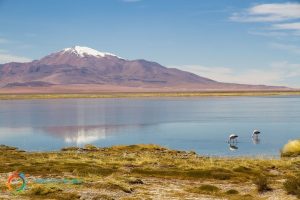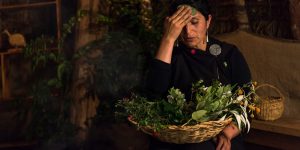A New Travel Trend for Tomorrow: Solo Tourism
By: Chile Travel - 28 August, 2021

Chile is a country with treasures of infinite tranquility, a place where the desire to see only nature increases at every step. Isolated areas with pristine nature are the perfect choice for some solo tourism, away from crowds, only in contact with open landscapes of pure life, which you can explore with your backpack.
Do you have an inexplicable passion for being away from the city? Do you fantasize about places where “social distance” is not an imposition, but rather the norm? One of the new travel trends is solo tourism in large open spaces of nature, and Chile offers these experiences where, paradoxically, isolation, limited access to technology, and remoteness may be the cure for the modern anxieties of the excess distance.
On days where the desire of many is to travel through vast forests and walk into territories of untouched wildlife, Chile presents these travel alternatives that can be considered a luxury for the soul.
In this article, we give you the best tips and recommendations for tomorrow’s tourism trend: Solo traveling, away from large groups, with little internet connection, but with vital natural connection.

North of Chile
Atacama Desert
The desolate landscape of the desert has a resemblance – according to experts – to the surface of Mars. Its extreme temperatures and more than 100 km² of surface, are enough for you to decide to visit it if what you want is to feel that there is nobody else in the world.
Specifically, in the driest desert on the planet, you will be embraced by an overwhelming silence surrounded by volcanoes, highland lagoons and wetlands, and salt flats. It’s important to consider that you should travel by car for your safety.
One of the loneliest places in the desert is Quebrada de Paipote, located 32 kilometers northeast of the city Copiapó. This “Quebrada” or “Deserted Valley” is the home of the Tamarugo, a native tree that has managed to survive in a hostile environment, the scarcity of water, and the variations of the temperature between day and night. Here, life occurs in curious and inexplicable ways.
However, we cannot forget the small town of Quillagua, which in the Aymará language means “Valle de Luna” (Moon Valley), located 600 kilometers away from the city of Santiago and 280 kilometers north of Antofagasta, one of the main cities of the north of Chile.
According to National Geographic, it is the “driest place in the world”, with only 0.2 millimeters of rain over the last 40 years. Summer is hellish and during winter, the wind doesn’t stop. Here the electricity only lasts about eight hours a day and you will not find drinking water or any other distraction beyond the dry hills and the stories of the almost 150 habitants -most of them elderly- of this oasis.

Despite the dryness and the almost zero plant life, that doesn’t mean that you can’t find any other “type” of life or vibrations around here. You will feel abundant energy, clean skies perfect for astronomy, diverse culture of people who inhabited the area before the arrival of the Spanish conquest, and a rich ancient history.
For astronomers or fans of stargazing, the sky of the Atacama Desert offers the unique opportunity to do this activity. It is often chosen for experts as one of the best destinations for this practice, where silence and loneliness, plus the wonderful sky, give the rare chance of observing the space and understand our minimal presence in the universe.
And, for even more motivation, our desert has been the scene of great film productions. For example, in 2008 scenes from the James Bond saga “Quantum of Solace” and “Motorcycle Diaries” were filmed here.
A special fact: Research has concluded that what we know today as the desert, was under the sea more than 100 million years ago. Amazing!

Altiplano
If you are attracted to high altitudes, with more than 4,000 meters above sea level to be exact, a getaway to the Chilean Altiplano (highlands) is your best option. Many believe that finding life at such height is impossible, but there is. And plenty of it.
To start an excursion, you must bear in mind that it will have a medium level of difficulty and various conditions are required. You will have to travel with supplies such as: plenty of water, provisions, coca tea (which according to residents, it helps to overcome the “altitude sickness”), sunscreen, adequate clothing, and gasoline or oil for the car. We recommend you travel with extra tires and spare tools in case your vehicle has a problem. You can start your journey from the cities of Calama or Antofagasta in northern Chile.
In the Altiplano you will come across a desert landscape where you will find towns that were human enclaves with hundreds of people, while today the total population does not exceed 500. Such is the case of Socaire, a place that rises above 3,500 meters above sea level, whose closest town is Camar, 25 kilometers away, or the popular San Pedro de Atacama, 86 kilometers away. In Socaire there are no basic services and it is the last Chilean point before the border with Argentina.

Chiu Chiu is another location you can visit. It’s just 30 kilometers away from the city of Calama and its central church, called “San Francisco de Chiu Chiu”, dates from 1540. It is considered a National Monument as it is the oldest in the country.
The town of Ayquina, located 74 kilometers away from Calama, is one of the most uninhabited you will find during your journey. Here you will only be able to see people during September when the carnival is celebrated in honor of the Virgin of Guadalupe and the silence is transformed into dance, colors, and festivity. This event, called “Fiesta de Ayquina“, is filled with religious dance and rituals that last an entire week, with 70,000 people dancing and thanking to the Guadalupe Virgin or “Chinita”. The rest of the year, only 50 people live in the town of Ayquina.
18 kilometers north of Ayquina we find Cupo, a village of 50 people who mostly speak the Quechua language and offers overwhelming tranquility. At this point, you can truly disconnect from reality and visit every corner of this town. If you are already planning your trip, we recommend doing it during the fall or spring season. During the summer (January to March), the rains caused by the Altiplanic Winter make transit impossible in the entire area.

Central Chile
Alejandro Selkirk Island
If you like solitude and the sea, this is your ideal place to contemplate the immensity, feel the silence and connect with the most intimate of your soul. The small Alejandro Selkirk Island, called until 1966 “Más Afuera,” is part of the Juan Fernández Archipelago, and is located 800 kilometers from the nearest coast of Valparaíso and 165 kilometers from the Robinson Crusoe Island, the one with the most population.
It’s a small island with no more than 48 km² of territory. Practically unknown place, remote and isolated, with difficult access and disturbing beauty, that is rarely visited by foreigners. You won’t find any of the comforts from the city such as cars, cable TV, fast speed internet or even steady electricity.
However, the treasure behind this trip will be unforgettable landscapes with endemic nature, crystalline waterfalls, pools of water in the middle of deep gorges, one of the most privileged bird sanctuaries of the planet, and a physical and mental rest that you will appreciate.
Additionally, the island has a dark history looking back to its days as a penal colony for political prisoners in Chile in the XIX century and some other incredible stories. Like, when the American writer Jonathan Franzen went in 2011 to scatter ashes from his friend, also writer David Foster Wallace. At the end of his journey, Franzen called Selkirk “the most dramatically beautiful place he had ever seen” and wrote his personal journey in an essay called “Farther Away,” published in New Yorker Magazine.
How to get there? The Juan Fernández Archipelago is accessed by plane, but to get to the island, you must be very lucky, and ask insistently if any ship accepts you into its crew. These boats only travel to leave oil and provisions for the fishermen who settled in the place to collect lobsters. They stayed at the island for seven months, from October 1 to May 1. Juan Fernández’s trip to Selkirk can last 14 hours, and if the weather does not help, you will have to withstand strong winds and waves that can reach six meters.

South of Chile
Araucanía
The Araucanía is located 675 kilometers south of the city of Santiago. A place that for centuries was the bastion of indigenous peoples such as the Pehuenches and Mapuches who faced the Spaniards during long battles.
In this fertile land with beautiful Araucarias (Mapuche’s sacred tree), it’s possible to access by plane or car, with a travel time of approximately 3 hours by air, or 10 hours by land. If there is something to know before traveling to any destination in La Araucanía, it is that you must have a deep respect for the “Pachamama” (Mother Earth) and the Mapuche worldview.
In this place, each araucaria, volcano, river, lagoon, the stars, the sun, the moon, and everything has a powerful meaning for the beliefs of its inhabitants. In this area, the landscapes to rest and enjoy nature are endless.
90 minutes from Temuco, the biggest city of La Araucanía, you can visit the Malalcahuello-Nalcas National Reserve, an immense park with many -mostly active- volcanoes, waterfalls, lagoons, ski centers and places for sport activities in a truly green environment.
La Araucanía also offers National Parks such as the Villarrica, Tolhuaca, Huerquehue, and Conguillío. Here, what prevails is the serenity surrounded by magical forests, mineralized thermal waters with temperatures that sometimes exceed 40 ° C, trails to do sighting of wild animals and an excellent food culture with years of tradition, offered by residents that still preserve the roots of the indigenous tribes that inhabited for centuries.

Are you looking for solitude mixed with nature? Icalma is the right destination. Mapudungún (the language of the Mapuche) means “Mirror of Water” because the mountains that cover the forest of araucarias are reflected in the lagoon that begins at the foot of the volcano. Here you will feel the vastness of nature and delight with the mythological stories about strange creatures and unknown animals that supposedly live in the forests and mountains that surround the place.
Carretera Austral
Much further south of La Araucanía, we can travel through “Carretera Austral” (Austral Road). But where does it start? The first thing you should do is get to the city of Puerto Montt and then head to Caleta La Arena. There you must cross by ferry to resume the road to the town of Hornopirén.
Every hour of this unique road trip will be worth it. You will see an endless number of places in the more than 1,200 kilometers of natural beauty, such as the turquoise lagoons, rivers, thick forests of ancient larches, and the most well-known national parks of the country, that protects and conserve the endemic flora and fauna.
Carretera Austral can be divided into three: The first section starts in Puerto Montt to the small town of La Junta. Here is the Pumalín Douglas Tompkins National Park that has over 400,000 hectares, filled with pristine nature, majestic landscapes, and delivers the rare opportunity of seeing hundreds of birds and animals that are part of the conservation program of the park.

The second section begins in La Junta and ends in the city of Coyhaique, an ideal place to reload provisions because as you go south, the distance will be longer. In this area, you can go to the beautiful Queulat National Park and walk the 3.2 kilometers trail to the “Ventisquero Colgante” and see up close the fantastic glacier, surrounded by nature and away from crowds.
The last part of the “Carretera Austral” begins in Coyhaique and ends int the town of Villa O’Higgins. At this point, you can go out and explore the Mosco river, visit the Cerro Castillo National Park, which is perfect for trekking lovers, but completely away from large groups. Since this park is relatively new, it doesn’t have any lodges or significant accommodations, just the 51 kilometers circuit, filled with stunning the mountain range and the native flora and fauna that live in the park.

Navarino Island in Tierra del Fuego
Finally, in what is known as “the end of the world”, we find Navarino Island. A mysterious place that is not very popular amongst foreigners, and that is part of the Tierra del Fuego Archipelago.
Getting there is not easy. It’s located more than 500 kilometers from Punta Arenas (Chile’s southernmost city), and the only means of connection is a ferry that sets sail only once a week and takes 33 hours. However, there are also aeronautical companies with daily frequency if the weather allows it.
Navarino Island is a wild and virgin territory, with Magellan forests of native trees, mountains, rivers, and lakes that practically have not been intervened. The most adventurous visitors can hike for three to five days through “Dientes de Navarino”, a mountain range that resembles a set of teeth.
In this beautiful piece of land, you will be amazed by an almost unknown sea fauna, mainly of dolphins, whales, killer whales, and sea lions. You will also be able to spot penguins, condors, and seagulls and if you are into photography and animal watching, in Navarino Island, you will see some beautiful species.
The best time to visit Isla Navarino is from December to March, and the closest town is Puerto Williams, with a population of 2,200.



















